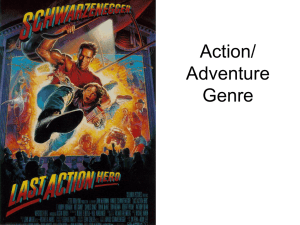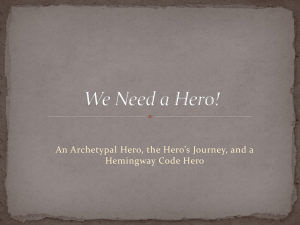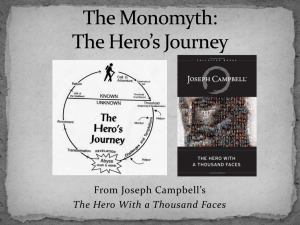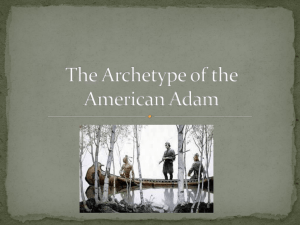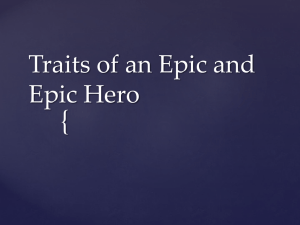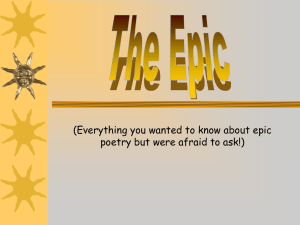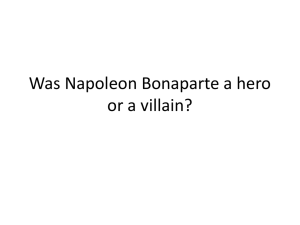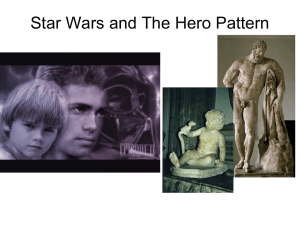Quest and Hero`s Journey Power Point
advertisement
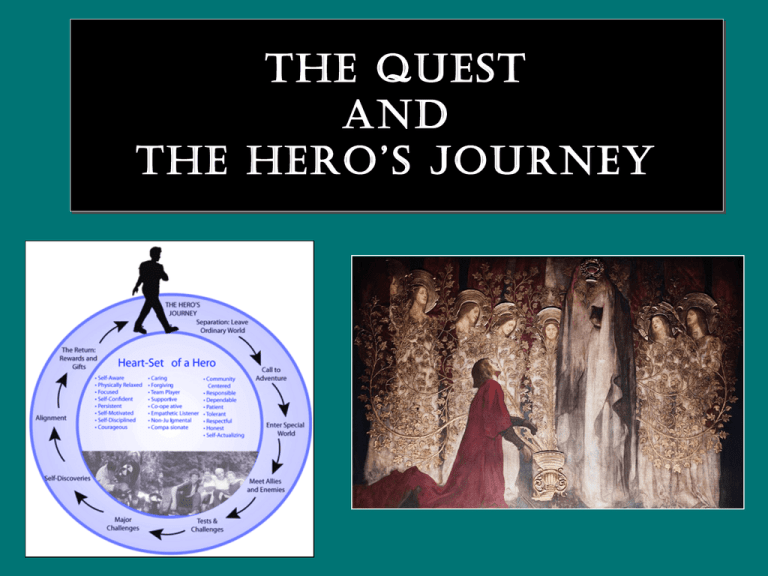
The Quest and The hero’s Journey ARCHETYPE: A UNIVERSAL SYMBOL ARCHETYPE: A pattern or prototype, such as a type of story, character, or common theme that is repeated in literature and reflective of the human experience. THE QUEST / HERO’S JOURNEY And Stonehenge… is one of the oldest story archetypes on the planet. Some say it is older than the Pyramids… And even cave drawings. The Quest THE QUEST: Literature based on a journey, a road of trials in which a hero hears a call and leaves his home—alone or in the company of others—to search out a treasure. Along the way he undergoes trials, receives aid, fights enemies and may even die, and, if he succeeds in attaining the treasure sought, may change who and what he is, as well as the community he returns to. THE QUEST has appeared in cultures throughout history. .. Homer’s Odyssey Ancient Greece 8th Century BC Gilgamesh Ancient Mesopotamia 18th Century BC Virgil’s Aeneid Ancient Rome 29-19 BC THE QUEST THE HOLY GRAIL The Arthurian Legends Le Morte de Arthur Sir Thomas Mallory 1470 Chretian de Troyes’ “The Story of the Holy Grail” from Perceval Late 12th Century Monty Python and the Holy Grail The Bridge of Death PERCEVAL AND THE FISHER KING Chrétien de Troyes' Perceval Continuation of Perceval The Vulgate Cycle Malory's Morte D’arthur (King Pellam) T. S. Eliot's The Waste Land Wolfram von Eschenbach’s Parzival (Anfortas the Grail King) Wagner’s Parsifal http://www.lib.rochester.edu/camelot/Fisherking/fkessay.htm PARSIFAL’S ENCOUNTER WITH THE FISHER KING BY FERDINAND PILOTY THE FISHER KING Trailer Parry tells the story of “The Fisher King” The Fisher King “The Red Knight” THE QUEST The Canterbury Tales Geoffrey Chaucer Late 14th Century Dante’s Inferno 1308-1321 Don Quixote Miguel de Cervantes 1605-1615 Gulliver’s Travels Jonathan Swift 1726 THE QUEST Candide Voltaire 1759 Jane Eyre, 1847 Charlotte Bronte The Catcher in the Rye J.D. Salinger 1951 Song of Solomon Toni Morrison 1977 THE: QUEST MYTHIC RETELLINGS +2,400 years Oedipus Rex Sophocles 429 BC Kafka on the Shore Haruki Murakami 2002 WNB: How does the quest motif shed light on Their Eyes Were Watching God? •What is the physical journey? Where is Janie going? •What is the apparent purpose of the quest—the “holy grail?” •What initiates the quest? •What is the real reason for Janie’s quest? •What are the obstacles and challenges? •How is her quest structured? •How does she know when the quest is completed? •How does the quest archetype echo and add layers of meaning to the novel? The Hero’s Journey Carl Jung Collaborator and friend of Freud Collective unconscious = inherited fantasy life Archetypes = basic components of human psychic nature The hero = an important archetype Carl Jung 1875 – 1961 Swiss psychologist/ psychiatrist Just as the human body shows a common anatomy over and above all racial differences, so, too, the human psyche possesses a common substratum transcending all differences in culture and consciousness. I have called this substratum the collective unconscious, … [which] is … the brain structure irrespective of all racial differences. JOSEPH CAMPBELL (1904 – 1987) • American mythologist, • • writer and lecturer, best known for his work in comparative mythology and comparative religion. His work is vast, covering many aspects of the human experience. He is best known for his definition of a HERO. “FOLLOW YOUR BLISS.” ORIGIN of ARCHETYPES Joseph Campbell recounts a curious phenomenon of animal behavior. Newly hatched chickens, bits of eggshells still clinging to their tails, will dart for cover when a hawk flies overhead: yet they remain unaffected by other birds. Furthermore, a wooden model of a hawk, drawn forward along a wire above their coop, will send them scurrying (if the model is pulled backward, however, there is no response). "Whence," Campbell asks, "this abrupt seizure by an image to which there is no counterpart in the chicken's world? Living gulls and ducks, herons and pigeons, leave it cold, but the work of art strikes some very deep chord!" In his book, The Hero with a Thousand Faces, Joseph Campbell asserted that all storytelling follows the ancient patterns of myth, and that all stories use elements of the Hero’s Journey. THE MONOMYTH. Christopher Vogler, a Hollywood filmmaker, was inspired by Joseph Campbell’s idea of the Monomyth . In his book The Writer’s Journey, he demonstrates how writers can apply this ancient mythic structure to modern film. First Major Section of the Cycle Departure Stage 1: Call to Adventure A character exists in an ordinary world A herald or announcer appears and indicates to the hero that his life is about to (or at least has the potential) change The call promises both treasure and danger. The call requires travel to a distant land, forest, or kingdom somewhere underground, beneath the waves, above the sky, on a secret island, atop a lofty mountain—even into a profound dream state. The hero must leave the ordinary world. Odysseus is called to fight the Trojan War Pinocchio wants to become a real boy. Dorothy wants to leave Kansas. Campbell says this about the Call to Adventure: The call [is] a … moment, of spiritual passage, which, when complete, amounts to a dying and birth. The familiar life horizon has been outgrown; the old concepts, ideals, and emotional patterns no longer fit; the time for the passing of a threshold is at hand. Stage 2: Refusal of the Call Almost all heroes at first refuse the adventure. The consequences of finally accepting the call: The person gains self-awareness and control. The consequences of always refusing the call: According to Campbell, the person’s “flowering world becomes a wasteland of dry stones and his life feels meaningless.” Dorothy runs back to the farm and Auntie Em. A storm is brewing. Luke Skywalker doesn’t have time for the adventure - he has to help his Uncle Owen on the moisture farm. Campbell says this about the Refusal of the Call: The refusal is essentially a refusal to give up what one takes to be one’s own interest. Stage 3: Supernatural Aid (Meeting the Mentor) Usually [but not always] masculine in form Typically a wizard, hermit, shepherd, or smith—someone peripheral to the community Supplies the amulets and advice that the hero will require to begin The ruby slippers Luke receives his light saber from Obi-Wan Kenobi. Campbell says this about the Mentor and the Supernatural Aid: For those who have not refused the call, the first encounter … is with a protective figure … who provides the adventurer with amulets against the dragon forces he is about to pass. Stage 4: Crossing the First Threshold The hero leaves the old world behind and enters the new. Dorothy is carried away to Oz by the tornado, and she begins her journey on the Yellow Brick Road. Luke Skywalker leaves his home on Tatooine. Campbell says this about Crossing the First Threshold: The hero goes forward in his adventure until he comes to … the entrance zone of magnified power. Beyond … is darkness, the unknown, and danger. Stage 5: The Belly of the Whale The belly = the adventure, where the rules are different. The hero is to be born again, undergo a metamorphosis, shed his old character for a new one. For some, the Belly of the Whale experience is a situation in which the hero feels trapped. Like Jonah and Pinocchio, the hero experiences the “dark night of the soul” and must face his faults and the truth. Luke Skywalker trains with Yoda in a whale-like house. Luke, Han, and Leia are trapped in the Death Star Garbage Compactor. Second Major Section of the Cycle Initiation Stage 6: The Road of Trials The hero must prove that he is worthy of the quest. This stage is PREPARATION or TRANING for the final challenge. Dragons must be slain, victories won, barriers passed, ecstasies experienced, etc.-- usually in series of threes. A series of tests, tasks, or ordeals (often in sets of three) that the hero must undergo to begin the transformation. In The Wizard of Oz, Dorothy must first navigate the dangers of the Yellow Brick Road before she can get to her ultimate goal. Campbell says this about the Road of Trials: Once having traversed the threshold, the hero … must survive a succession of trials. Stage 7: Meeting with the Goddess Usually depicted young and/or beautiful Teaches the hero an important lesson. Does not have to be a goddess [such as the Greek Athena or the Egyptian Isis]. Any strong female or feminine force meets the requirements for this stage. It could also be some kind of self-discovery. A wise or magical woman gives guidance or advice to the hero. Stage 8: Woman as Temptress Woman is the metaphor for the physical or material temptations of life. A temptation tries to lead the hero off his path of adventure. The “woman” can be a female, a strong feminine force, or a temptation representing lust, comfort, and/or lack of spirituality. Someone or something tempts the hero to leave the “true path” to his goal. Luke is tempted by the Dark Side of the Force; Frodo is tempted to keep the ring for himself; Circe the witch tries to keep Odysseus on her island. Campbell says this about the Woman as Temptress: Not even monastery walls, … not even the remoteness of the desert, can defend against female presences; for as long as the [hero’s] flesh clings to his bones and pulses warm, the images of life are alert to storm his mind. Stage 9: Atonement with the Father Atonement = at + one + ment The hero encounters his biological father, a father figure, a strong male presence, or someone or something with incredible power. At first, the “father” represents what the hero despises or disagrees with. The hero is killed during the encounter--either literally or symbolically--so that a new self can come into being. I am a Jedi, like my father before me! Dorothy faces the Great Oz! Campbell says this about the Atonement with the Father: There is a new element of rivalry in the picture: the son against the father for mastery of the universe. Stage 10: Apotheosis Exaltation of divine rank or stature. The hero recognizes his/her true identity - that spark of divinity within. The hero becomes “godlike” by performing a miracle or accomplishing something no one thought possible. Dorothy melts the Wicked Witch and the guards bow to Dorothy. May the FORCE be with you! Stage 11: The Ultimate Boon All previous steps have prepared and purified the hero for the boon. A difficult task is accomplished with great ease. The boon is sometimes the goal of the adventure--a magical elixir, the holy grail, a golden fleece. There is a catharsis– the hero comes close to death. Dorothy returns to Emerald City with the witch’s broom. Luke destroys the Death Star. Third Major Section of the Cycle Return Stage 12: The Refusal of the Return The Hero has proven that he is a new person The Adventure is over. How could anyone go back to life the way it was? A period of indecision. The hero wonders if it’s possible to return to the old life now that so much has changed. The Great Oz flies away alone in the hot air balloon, so Dorothy loses hope that she will get home. Campbell says this about Stage 12, the Refusal of the Return: The hero-quest requires that the hero return. The responsibility has been frequently refused. Stage 13: The Magic Flight • After you’ve stolen • • the golden idol, how do you get out of the crumbling temple (or exploding space ship, etc)? The first dangerous steps of the journey are often retraced in rapid fashion. We know the battle has been won, but we need to see the loose ends tied up. Stage 14: Rescue From Without • After the Magic • • Flight, the hero is often left wounded, or dangling on the edge of a cliff. He may need help returning to the ordinary world. An ALLIE or MENTOR or even a bad guy turned good often brings the hero out of danger. But you’ve always had the power to go home! Glinda the Good Witch reminds Dorothy of the ruby red slippers. Campbell says this about Stage 13, Magical Flight: The final stage of [the hero’s] adventure is supported by all the powers of his supernatural patron … or complicated by … magical obstruction. Campbell says this about Stage 14, Rescue from Without: The world may have to come and get him. Society is jealous of those who remain away from it, and will come knocking at the door. Stage 15: Crossing the Return Threshold • The hero steps out of his active role. • He either finds himself back in the old Ordinary World, or in a new, balanced world that his quest has created Dorothy finds her power to return to Kansas on her own by wishing for home. Campbell says this about Crossing the Return Threshold: He [must] re-enter … where men who are fractions imagine themselves to be complete. Stage 16: Master of the Two Worlds • Every story has an • external conflict (to find the Holy Grail, to rescue the maiden) and an internal conflict (to become worthy, to gain confidence) The Master of Two worlds is when we have evidence that the hero has solved both conflicts Stage 17: The Freedom to Live • You know the feeling at the end of the movie where you just know that everything will be alright, even if the future is uncertain? THAT is the FREEDOM TO LIVE Dorothy returns to Kansas and is welcomed by all her family. “There’s no place like home” Campbell says this about Stage 16, Master of Two Worlds: Powerful in insight, calm and free in action, … the hero is the conscious vehicle of the terrible, wonderful Law of the Universe, whether his work be that of butcher, jockey, or king. Campbell says this about Stage 17, Freedom to Live: Freedom to pass back and forth across the world division … is the talent of the master.
